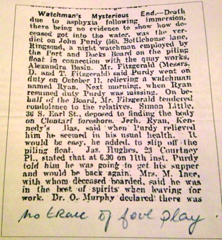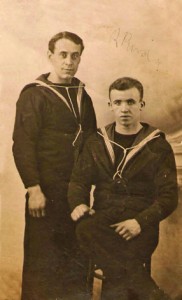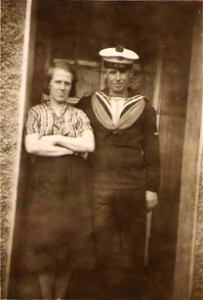
A few months ago I was watching the TV programme Countryfile when a picture flashed up on the screen of a German U-boat covered in mud on the seabed. I think it was from the 1914-18 war and it was being shown on air for the first time.
Then the programme showed a convoy of ships leaving Liverpool for America. These ships were keeping Britain going through trade.
As a young boy living in Ringsend, I often heard conversations about the 1914-18 war. I always knew my father was in the Royal Navy because he kept a British war medal in a glass case on the tallboy in his bedroom. Ireland was under British rule then, so to seek work in England would have been normal at the time.
As recently as eight years ago, I discovered that my father’s logbook was kept in the family home in Whelan House in Ringsend and showed entries from the Great War. This prompted me to investigate my family’s history because, as a young boy, I was not allowed to ask questions and I never got any answers when I did.

I started by looking in the National Library of Ireland. My great-grandfather was a shipwright and the sea was in our blood from the time the family lived at number 4 Bridge Street, Ringsend in the 1800s. The house is still there.
I don’t have much more information on my great-grandparents but their son, my grandfather John Purdy, who was also a seaman, married Margaret Moore from Bath Avenue and they had five children, maybe six; Peter, Richard (my father), James, and two infants Mary and James (both died when a few months old) and there was a John who was in the 1901 Census but that’s all the information I found.
At the time, it would appear that my grandfather was working in the Dublin Port and Docks Board as a night watchman on one of the Piling Fleet. I discovered that he went on watch on the 11th October 1924 and was reported missing the next morning. His body was found at Clontarf foreshore on October 24th. I discovered the coroner’s report in the National Library with the help of a good friend. After some more investigation I found the newspaper clipping (pictured) relating to his death.
My own father Richard (Dick) Purdy joined the Royal Navy giving his age as 17, when he was in fact only 15. This was done by a lot of men during this terrible war. While it is recorded in his logbook that he was born in 1896, his official birth cert states that he was born on the 6th June 1899, which confirms my theory about his age on enrolment.

He was listed as a fireman and later as a trimmer in his logbook. Records show that he served on a ship called SS Kenrane Head Belfast which docked in Dublin on January 18th 1921. According to his logbook he received the British Star medal for service in 1914–15 and the Chevron medal in 1914. He also received the Victory medal. Unfortunately, none of these medals are in my possession.
My father got his discharge from the Royal Navy in Belfast on the 18th of March, 1921. I believe he came home to Ireland then because things were changing there and Ireland was close to becoming the Free State. In the 1901 Census his family lived in Shaw’s Lane, Sandymount. They also lived for some time, after he returned to Ireland, in Thorncastle Street, Ringsend. Throughout his career, his work and character is entered in the logbook as “very good”. During The Emergency 1939–45 he was enlisted in the Irish Navy and after that war went back to his job in the Dublin Port and Dock Board.

My father married my mother Margaret Curran in Westland Row Church on the 30th of April 1924. Her brother Henry Curran was also involved in the First World War. In the 1901 Census Henry was eight years of age. My mother’s family moved from Kerry to Scotland for what reason I do not know but at one point they lived at 2 Great Clarence Street, Dublin. Uncle Henry was living in Glasgow when he enlisted in the King’s Own Scottish Borderers (KOSB) 6th Battalion. His rank was Private. He was killed in action in 1917, aged 24. My reason for writing this is that a picture of him hung on the wall of the main room at 28a Whelan House, Ringsend. At family gatherings, when I was a very young child, aunts and uncles would talk about not knowing where he was buried. My mother died still unaware.
I think during the Second World War 11 men were identified by their dog tags when their unmarked grave was destroyed by shell fire in Tees Trench Cemetery No 2, Tilloy British Cemetery, Tilloy-Les-Mofflaines, France. These were the men of the 6th Battalion KOSB and one of the eleven was my mother’s brother Henry. Medals Awarded to Uncle Henry were the British War Medal and Victory Medal.

In this, my old age, I am happy to write this family history for my mother and my granny Curran who, in their reward in heaven, now know the story. I am proud too of what my father achieved. There must be lots of similar stories out there. You’re never too old to find out about your family history and you’d be surprised how accessible information is these days. The photos featured were only discovered since I started to write this article.
From top: Newspaper clipping relating to grandfather John Purdy’s death; unknown man standing, Richard Purdy seated (wearing the Royal Navy uniform); Margaret and Richard Purdy (Dick wearing the Irish Navy uniform); Uncle Henry’s grave is the last one on the right alongside the wall; Uncle Henry.
By Jimmy Purdy

